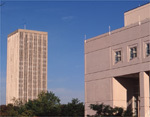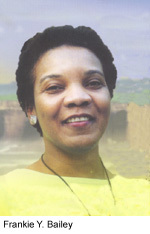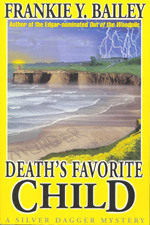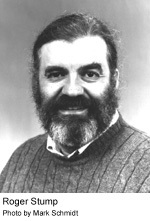

In Print
Death�s
Favorite Child, by Frankie Bailey
By Lisa James Goldsberry
When UAlbany criminal justice professor Frankie
Bailey visited her friend in England, little did she know that the brief
vacation would turn into a mystery novel.
Death�s Favorite Child (Silver Dagger Mysteries, 218 pages, $24 hardcover, $15 tradepaper), tells the story of Lizzie Stuart, a 38-year-old African American crime historian from Kentucky. When her grandmother dies, she joins her best friend Tess, a travel writer, for a week�s vacation in the English resort town of St. Regis. There, she becomes an eyewitness to murder and possibly the killer�s next victim.
This is the first book in what is expected to become a series featuring the Stuart character. Bailey made Lizzie a graduate of the University at Albany. �It all started when my friend, who is a graduate student, invited me to spend a week with her. However, I have been developing a mystery novel around this character for about five years,� Bailey said. �I used my trip to England as a backdrop to this story and I will bring the character back home for the next book.� Bailey said the title relates to the Stuart character and her search for identity.
Bailey is author of the Edgar-nominated Out of the Woodpile: Black Characters in Crime and Detective Fiction. She is also editor, with Donna Hale, of Popular Culture, Crime, and Justice. She and Hale are currently at work on Blood on Her Hands, a book about women, death, and murder.
Born and raised in Virginia, Bailey says she has always been interested in history, legend, family, and traditions, which are addressed in her book. She earned her Ph.D. in criminal justice from UAlbany and has been a professor here since 1990. Prior to joining the University, she worked at Kentucky State University as a professor and acting assistant vice president for Academic Affairs.
Geography
Professor Stump Publishes Boundaries of Faith
By Carol Olechowski
At first glance, religion and geography might seem to have
little, if anything at all, in common. Roger Stump sees it differently.
In his latest book, Boundaries of Faith: Geographical Perspectives on Religious Fundamentalism (Rowman & Littlefield Publishers; $69 cloth; $28.95 paper), Stump explores the relationship between fundamentalist movements and the particular places where they develop. His work also investigates how social or cultural groups attempt to control the meaning and uses of geographical space to advance their objectives, and how those efforts create spatial structures that constrain the activities of fundamentalists and of other members of society.
Much of Stump�s prior research focused on analyzing geographical patterns of religious behavior and religious change in the United States, usually based on statistical analysis of quantitative data. Several years ago, however, �I decided that I wanted to take my research in new directions by using more qualitative approaches and by extending my concerns to more global geographical issues,� explains Stump, an 18-year member of the Department of Geography and Planning faculty and a recipient of both the SUNY Chancellor�s and University at Albany awards for excellence in teaching.
Written as an original piece of research, Boundaries of Faith, says its author, �addresses issues that had not previously been examined in a systematic way by human geographers or other social scientists. I tried to present my ideas and conclusions in such a way that they would be of use to both students and non-specialists.� The publisher, Stump adds, hopes to market the work as a possible text for upper-division courses in geography, religious studies, and related fields.
It took Stump - a highly regarded expert on cultural geography, geography of religion, quantitative methods, and North America - about three years to research and write the book. The research, he notes, �is based primarily on archival materials, written materials produced by fundamentalist groups or their leaders, published news reports from a variety of sources, government documents from numerous countries, and the like.�
Boundaries of Faith focuses on both contextuality - the link between every fundamentalist movement and its setting - and territoriality, human efforts to control space. The book compares Islamic fundamentalist groups in Egypt, Iran, Pakistan, and Malaysia to illustrate the very different forms of fundamentalism that have emerged in these areas. Stump also touches on fundamentalist movements elsewhere in the world, with much of the text devoted to Hindu fundamentalism in India, Christian fundamentalism in North America, and Jewish fundamentalism in Israel.
Says Stump: � �Place� is one of the central concerns of human geography, particularly as it relates to the development of specific social and cultural contexts. I have attempted to show that several general factors are responsible for the development of fundamentalism in a place: the presence of a strong religious tradition followed by a critical mass of adherents; the presence of a threat to tradition that motivates those adherents to develop an exacting definition of true religious belief and practice; and the presence of a social context in which those adherents can actively express their religious solidarity and their opposition to the threats they perceive.�
In addition, �I demonstrate that territoriality is, in fact, an essential component of fundamentalism, but that it takes many forms,� Stump observes. �It may deal with various concerns, including the group�s sacred homeland, as in Hinduism and Judaism; the meaning and use of sacred space, as in the conflicts over control of sacred sites in Jerusalem; and the control of public space, as in the controversy over posting the Ten Commandments in public buildings. Different groups address these concerns in different ways - through political action, social pressure, or even terrorist activity.�
One of the most interesting things about fundamentalism, according to Stump, �is that it has emerged as a recognizable phenomenon in so many different forms and in so many different societies. Its impact over the past century has truly been global, affecting the nature of individual societies, the nature of social conflicts, and even conflicts between countries.
�The impact of fundamentalists in all of these settings is strengthened by their unquestioning acceptance of traditional religious truths as superior to secular rationalism; their absolute certainty that they alone understand ultimate truth; and their profound commitment to preserve and promote truth, as they see it. Because fundamentalists have been able to exert political influence, or even achieve political dominance, in various places, their global impact has been widespread. And because of their general unwillingness to compromise with others who do not share their beliefs, their impact is likely to be felt for some time to come,� concludes Stump.
Swiny, Students Excavate Cyprus Site
By Tim Kelly
Department of Classics Professor Stuart Swiny and 15 of
his students excavated an important archaeological site in Southern Cyprus
for six weeks this past summer.
�The purpose was to verify the degree to which the Bronze Age site at Pyrgos was involved in copper manufacturing, because articles had been published saying that it had been a major copper producing center,� said Swiny.
Copper was a very important strategic material during the Bronze Age because it was a crucial element in the manufacturing of weapons. Cypriot archaeologists still do not know how copper was smelted prior to Classical times, about 400 B.C., and any site where smelting occurred before that would be an important archaeological discovery.
Maria Rosaria Belgiorno, a researcher for the National Italian Research Institute, reported evidence of copper smelting at a site near the village of Pyrgos. Smelting was reported to have occurred there as far back as 2000 B.C., making it the oldest copper-smelting site ever discovered on the island.
Swiny and the students, under the official title of the University at Albany Archaeological Expedition to Pyrgos, uncovered evidence that disproved Belgiorno�s claim that copper smelting had been taking place in the areas she has excavated. Belgiorno had found features that she suspected were furnaces used for producing the metal. After last summer�s excavation, Swiny asserted that they were definitely not used for smelting copper, but may at best have played a secondary role in the manufacturing of finished copper objects.
�Copper was being smelted in the general area, but this was not happening where we were digging,� said Swiny. They did find quite a lot of copper slag, but he suspected that it had been produced as the result of smelting activities several hundred yards farther up the hill, not directly at the site under excavation.
The students were expected to actively participate in the excavation. Although Belgiorno and her students were there for the first two weeks, the rest of the time it was basically a University at Albany dig. They would start work at 6 a.m. and work through the intense Mediterranean heat until 2 p.m., then they would return to base, an elementary school in the village of Pyrgos. After lunch and a siesta, they would then spend an additional two hours counting and sorting pottery from the day�s dig.
�The Albany students were a great lot,� Swiny said. �They were tough, resilient, hard working, and they never complained. I�ve never had a better group.� The students faced obstacles that included temperatures over 100 degrees, dust, and insects.
The students, many of whom were participating in their first archaeological dig, were expected to work hard.
Bill Weir, a UAlbany senior and a first-time participant, said, �If you found it, you got to work on it,� regardless of skill level.
Corrine Hahn, who is studying classical archaeology at the graduate level and had been to Cyprus before, said, �It was a lot more difficult than I thought it would be. You really have to understand the different stratagraphic levels. It was definitely harder than I expected.� She had gone to Cyprus in 1997 with Swiny to survey for sites around the village of Sotira, 20 miles west of Pyrgos, but they had not done any digging. Hahn plans to return to Cyprus in January and June to do research for her thesis.
Christine Bicker, another senior, said, �I�ve had Stuart as a teacher before and I went in knowing that I was going to learn a lot. That�s totally what I got.� Bicker had participated in an excavation in Cyprus the previous summer. Although she had dug before, she said that the soil and time periods were different between the excavations. Bicker added that she had �learned what it takes to be out in the field.�
Swiny only brought UAlbany Cypriot archaeology students with him and many of them received University credit for participating in the excavation. He was assisted by his wife, Helena, who curates the Cesnola Collection of Cypriot Antiquities at the Semitic Museum, Harvard University.
�The students worked hard and enjoyed a great experience,� Swiny said. �What better education can you get?� He plans to go back to Cyprus next summer to resume work on the Early Bronze Age site he discovered near the village of Sotira.
The students also received an education in culture. Weir said, �They (the Cypriots) are incredibly nice, gracious people. You don�t have to worry about anything.� He added that �Cyprus was great� and that he plans to go back with Swiny next year.
Mentoring Program at Rockefeller
College Pairs UAlbany Students with State Administrators
By Greta Petry
When Peter Casale was asked to mentor a UAlbany graduate
student in public administration, he didn�t hesitate. As director of training
and organization development at the state Department of Environmental
Conservation, he encourages other managers to act as mentors by being
one himself.
�Besides, how do you say no to Michelle Marto?� he said. Marto, director of the Office of Student Professional Services at Rockefeller College, organizes the mentoring program, which pairs graduate students in public administration or public policy with successful public servants.
Marto said, �The goal of the professional mentoring program is to connect practitioners who are well versed in their particular fields with students who share common professional interests. We are fortunate at Rockefeller College to have dedicated alumni and �friends of the College� who are equally as committed to the education and development of the next generation of public sector professionals.�
Casale, a 1982 graduate of the UAlbany master�s in public administration program, has other ties to the campus as well. An adjunct instructor, he teaches a course in managerial leadership each academic year.
�This semester I am off, but since 1996, I�ve taught classes during the spring and fall semesters,� he said.
Casale acts as a mentor to Lynda Fleurismond, 23, of Rockland County, whose parents are natives of Haiti. A 1999 UAlbany graduate, she is a second-year student in the MPA program.
Casale said, �Lynda stays in touch about once a month. I prefer to keep the mentoring informal, because then it is easier, less onerous to the student, and less threatening.�
Casale said that having a mentor �really helps folks who have theoretical exposure to understand how the theories apply in the real world. The experience adds a richness and a context without having to do it on your own.�
Fleurismond said, �I learned firsthand the fundamentals of human resources management. I got to see great management firsthand and participate in the decision-making process. In addition, Peter has provided me with numerous professional contacts.� He also talked to her about joining professional organizations. �I recently joined the American Society of Public Administrators (ASPA), which has already proven beneficial,� she said.
Fleurismond chose to attend graduate school at UAlbany, �because I wanted to continue my education at this great institution. Its graduate public affairs program is ranked eighth in the nation (by U.S. News & World Report) and I truly believe that this school is like no other, with its dedicated faculty and staff. Not to mention I am getting a top-of-the-line education at a very affordable price.�
She concluded,�Overall, I would say that the Rockefeller College School of Public Affairs and Policy is a great program. In addition to its valuable mentoring program . . . it has a great internship program where students gain experience firsthand,� Fleurismond said.
At another state agency, the Office of the Attorney General, Judith Enck, policy adviser in the Environmental Protection Bureau, stays in touch with another UAlbany graduate student, Sonya Walter, by phone and by e-mail.
Enck, well known for her involvement with environmental advocacy, was executive director of Environmental Advocates from 1982 to 1987 and worked for the New York Public Interest Research Group (NYPIRG) for a decade before joining the Attorney General�s office.
�I develop policy initiatives for the AG�s office,� said Enck. �I do a lot of research, writing, work with community groups, and interact with policy makers on a broad range of environmental issues.�
Walter, 28, of Endicott, N.Y., is a second-year student in the master of arts in public policy program with a concentration in environmental policy. She attended the University of Massachusetts, Amherst, as an undergraduate.
Walter said UAlbany �had exactly what I was looking for. I was able to study environmental policy and it offered professional experience through internships.� She added, �What better place is there to study politics in New York State than in Albany?�
She and Enck simply discuss things of common interest.
Enck said, �What I�ve told Sonya is to work on issues that interest you and that you are passionate about; everything else falls into place. If you want to do environmental advocacy work, expect to put in long hours for very low pay, but it�s a wonderful career.�
Home Page/ Front Page/ Campus News/ Features/ Sports/ Date Book




